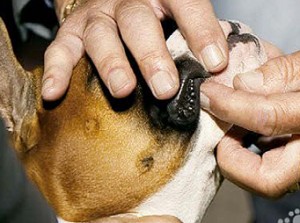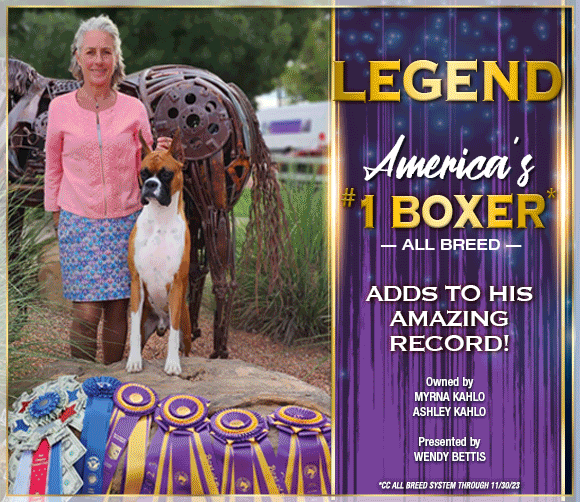The Power Of Positive Judging
By Wayne Cavanaugh
 FAULT judging comes pretty easy for humans in everyday life and in the sport. We seem to be wired, at least to some degree, to find fault in each other. Maybe it helps us feel better about ourselves. As dog fanciers, we can’t help but find fault in each other’s dogs. Maybe it helps us feel better about our own dogs.
FAULT judging comes pretty easy for humans in everyday life and in the sport. We seem to be wired, at least to some degree, to find fault in each other. Maybe it helps us feel better about ourselves. As dog fanciers, we can’t help but find fault in each other’s dogs. Maybe it helps us feel better about our own dogs.
We spend a lot of time talking to other people every day. For a good portion of that time, accordingly to Scientific American, we talk about ourselves. We spend the second biggest chunk of time talking about others. It’s no surprise that we typically have wonderful things to say about ourselves and less wonderful things to say about others. I couldn’t find any research regarding what we say about our dogs and other people’s dogs, but I’m guessing the same rules apply. As a human, I probably won’t be able to resist subconsciously doing a little of both in this article.
Accordingly, when we describe our own dogs, we speak enthusiastically about their positive traits. When we speak of other people’s dogs, we are more likely to speak with equal enthusiasm about their negative traits (at least when we think they aren’t listening). While “kennel blindness” may play some role, it’s probably just human nature. It might be the reason people watch Jerry Springer on television – their lives may not be perfect, but relatively speaking, they are way better off than the people on the show.
This human dynamic is naturally embedded in the pulse of our sport. The next time you are at a show, or just talking with other dog show friends, listen for the response when the topic of someone else’s dog comes up. Chances are pretty good that the first descriptive spoken words are negative. “Did you see Joe’s new special?” “His front is a disaster!”
Positive judging, instead of fault judging, does not come easy – it takes practice to think, see, and say positive things first. So, how can we adjust our thinking to instead say: “he’s beautiful dog, correct breed type, wish his front was better?” It’s not just a matter of being nice or polite.
It’s a matter of reframing the dog judging process in our heads so we can learn to focus on virtues, breed-specific details, and make our day and the exhibitor’s day a more positive experience. Miserable judges are a drag on the sport and a dagger to the exuberance and retention of new, and even veteran, exhibitors. So how do we work on being more positive judges; virtue judges instead of fault judges?
About ten years ago, sporting dog judge and successful English Springer Spaniel breeder (not to mention number one Vince Gill fan) Kathy Lorentzen developed and presented an excellent seminar with a section called, “The Power of Positive Judging.” The goal was to ask judges to see the good in every dog they judged. Over the next few years, the late, great Jim Edwards and I had the opportunity to expand Kathy’s positive judging piece and include it as a four-hour section in our two-day seminar. One of the reasons the Positive section was extended to four hours was that it took that long to start to get everyone out of the natural fault-finding mindset. Only then could they find ways to explore the power of positive judging.
Jim Edwards and I did a lot of those two-day seminars over a span of six years and always included the Power of Positive Judging section. If they were “all-breed seminars” it was only because they weren’t “breed seminars.” We had no intention to teach anyone how to place the dogs. Instead, the goal was to focus on ways to learn about and describe the dogs. First, we didn’t happen to have 193 breed experts on hand at every seminar. Second, who were we to think there was only one definitive way to place a class by looking at giant photos? Third, there are plenty of other seminars for that kind of thing.
We started the seminar talking about approaches to positive judging. Specifically, we gave examples of how to think about other people’s dogs in a positive light. Then, we put slides up of four dogs of the same breed and asked the participants to discuss each dog. Not to place them, just to describe what they saw. Every seminar, every time, the natural proclivity of participants was to start the description of each dog with a negative comment. It usually took about an hour for everyone to be self-aware enough to consciously bite their tongue and focus on breed-specific positive traits instead. Even when they got rolling, there would be occasional slips followed by a spontaneous collective reminder from the group suggesting the speaker get back on track. Along the way, we all learned it was easier to catch someone else slipping up than it was to catch our own mistakes.
In addition to the Positive Judging section, there was a breed standard section where we asked participants to consider some different “outside the box” ways to approach standards. We included, for example, ways to compare dogs to other species, from horses to giraffes, and the importance of studying early dog art to consider the timeline of each breed’s development. Jim did a tremendous section on canine anatomy as only he could, and we wrapped up with a section on the future of purebred dogs. One constant throughout all sections was the emphasis on learning to use relative root-breeds, breed function, and breed history to assist in finding virtues while describing the dogs on the slides we showed.
When participants said things like, “nice head,” “good tailset,” and “pretty outline” they were kindly asked to explain what those words meant relative to the breed. Why was something considered a “nice” head, “good” tailset and “pretty” outline? Those words weren’t the least bit breedspecific; they were simple and trite. Fortunately and consistently, as each seminar unfolded, participants began to incorporate the appropriate breed-specific details in positive descriptions. The tendency towards nebulous, generic words that conveyed nothing about the key elements of a breed took a back seat. With reminders and practice, that is!
One thing we all discovered about positive judging is that it cannot be done without knowing how to describe and consider breed-specific traits. How many times can we say “showy,” “pretty,” and “nailed the stack” in good conscience if we are truly describing the virtues of a breed? If, however, we can learn to walk down a line of dogs and find the breed’s unique virtues, then sort the dogs by which dogs have the most positive features, everyone’s a winner.
Yes, those seminars were different. Perhaps the only thing in common with other seminars was the division of student types – serious students and unabashed certificate collectors. It usually took about 15 minutes to sort out who was who. Either way, we had no intention to teach participants which dogs to pick because that wasn’t the point. We actually wanted to learn as much from them as they did from us. Most important, we wanted everyone to leave with a new set of questions they could ask themselves on the perpetual journey of learning. We wanted to give them new ways to unlock breed standards and new ways to approach learning. And we wanted both the questions and answers to be framed in a positive light.
Did it work? I don’t know. The anonymous reviews were always 100% highly favorable but that is only a moment in time, a small piece of a puzzle. Did participants actually go home with new ways to learn and new questions to ask? I hope so, but actually have no idea. Did they remember the “Positive Judging” part? While strictly anecdotal, people who attended told me years later that they remembered the section, enjoyed it, and tried their best to apply it with, or without, success. After all, we are humans.
So why is a positive approach to judging so important for the future of the sport? First, it reminds us that every purebred dog has something good about them if we are willing to look, if we are willing to take the time to appreciate the virtues. And it helps us to not fall into the pattern of fault judging. Fault judging is an insidious beast that not only makes for inferior judging, it also makes judges miserable. We’ve all shown under a miserable judge. Or maybe we’ve even been one. Every dog is horrible, the breed has been ruined, and I have a flight to catch. Oh, what fun! Let’s do it again next weekend! Why? If that is the judge’s mindset, why don’t they find another sport that makes them happier? Life’s too short. A miserable judge makes for miserable exhibitors and a general atmosphere of dog show miserableness – no one wants that! Aren’t dog shows supposed to be enjoyable? Well, how can anyone have fun without looking for virtues instead of faults? How can we celebrate all that is exciting and wonderful about the purebred dogs we love, the sport we love, and the friends that share our passion?
We are humans, spectacular but imperfect humans, with an innate tendency to say nice things about ourselves and our dogs and less nice things about other people and other people’s dogs. Except, however, in those beautiful moments when we rise about the negative fray. For example, how much fun is it to see an excellent dog for the first time, or find a youngster who turns out to be a great one? Those epiphanies are enjoyable and positive. They are so much fun that we spontaneously jump on the positive train to the point where we cannot wait to tell everyone how great the dog is. And it’s not even our dog! See, it can be done.
Seeing things we love in a positive light is good for dogs, good for us, and good for the sport. If we can learn to have the insight to apply it outside the sport, it can be the perfect antidote for an increasingly negative and critical world.
Fault judging both dogs and people is a drag on the canine and human species. No one is asking everyone to be bubbly and smiley on the outside! Judging is serious stuff. However, trying to be inwardly positive in assessing dogs and seeing virtues before dwelling on faults goes a long way. Walking down the line and focusing on faults in dogs first is non-productive, no fun, and creates grumpy old men and women before their time.
Short URL: http://caninechronicle.com/?p=280151
Comments are closed












